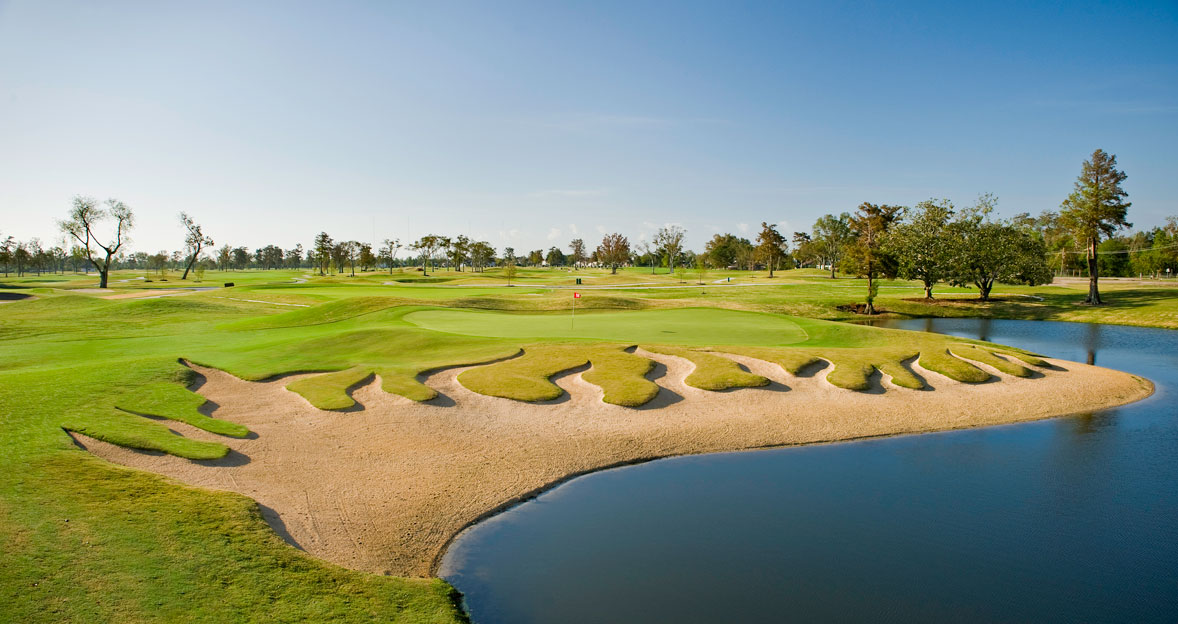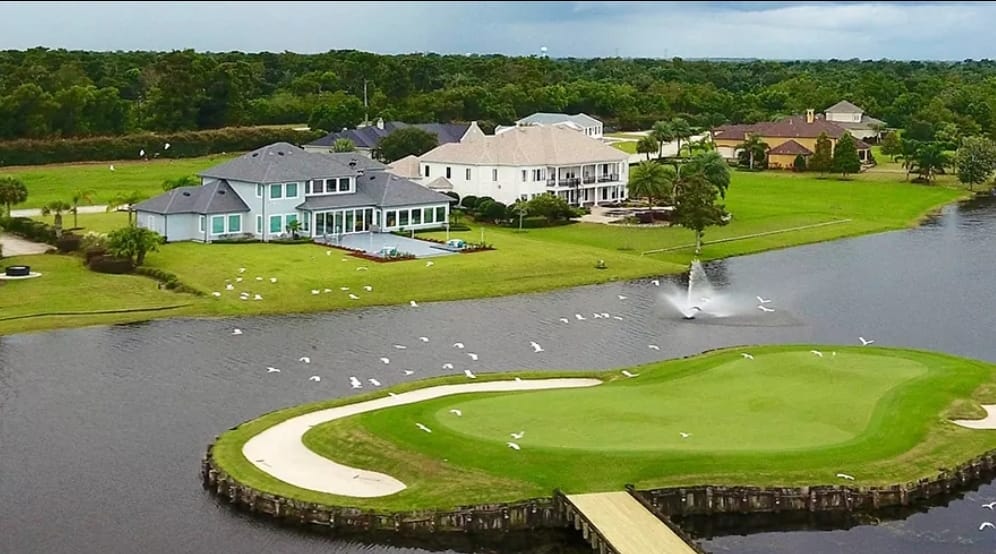
Lakewood Golf Club
If you’ve ever been to New Orleans, you know that the city offers tourists a bit of everything and a little of anything — there’s things that go on in the Big Easy that just don’t in your hometown.
There’s the excess of Bourbon Street’s clubs, fine dining, art galleries and museums, street cars, the Mississippi River in all its glory, horse racing, jazz music everywhere, and — for our purposes — a roster of public access golf courses that run the gamut from great to good.
Golf in NOLA is hard to throw a blanket over — there’s the long (TPC Louisiana) and the short (Audubon Park Golf Course and the North Course at Bayou Oaks at City Park) and there’s the semi-private (English Turn Golf Club) and the public (Lakewood Golf Club and Stonebridge Golf Club).
Suffice to say that if you’re ready to roll out of bed in the early morning after trying to outlast Bourbon Street until the wee hours then there’s plenty of memorable places to play golf in the Crescent City. Just grab yourself a Café au Lait and a bag of beignets at Café Du Monde and within the half-hour it takes for you to clear your head you can drive to any of the above listed courses.
Let’s look at three of the golf courses we got to play on our latest trip to New Orleans.

TPC Louisiana
TPC Louisiana is demanding and lengthy, but also a lot of fun
The first place I always secure a tee time for when I know I’m going to NOLA is the TPC Louisiana. It was fashioned out of swampland by Pete Dye, opened in 2004 and then being softened a bit through the years to make it more playable.
TPC Louisiana, the home of the Zurich Classic on the PGA Tour each year, has very little rise and fall but has more than enough trees, swampland, and bunkers to make it plenty challenging. This is not an overly difficult course for low handicap players, and its five sets of tees make it one of the most playable courses used for a Tour event that us mere mortals can also tee it up on.
What Dye’s creation demands is length and accuracy off the tees and the ability to hit long irons with a modicum of reliability. If you can put those aspects of your game together then you can have some success at TPC Louisiana.
Three of the par 5s here are memorable. The seventh, carded at 561 yards, has a volcano bunker in the middle of the fairway to focus the big hitters who want to try to go for the green in two; shorter hitters will find success as well if the layup stays on the right side of the fairway to set the table for an easy wedge into the green.
No. 11, which plays at 575 yards, features a massive cypress tree in the middle of the fairway about 100 yards from the green, forcing the player to position his approach to either go around, over or under the sentinel to find the putting surface.
The signature hole on the golf course is the 585-yard, par-5 18th with water in play for the entire right side of the hole, making for a challenging finish for golfers of all skill levels.
Dye worked in conjunction with Steve Elkington and Louisiana native Kelly Gibson, both former Tour players, to create a 7,425-yard, par-72 track that sits low on the property and utilizes natural vegetation, including numerous cypress trees. One of the most attractive features to the property is that it’s self-contained, surrounded on three sides by drainage canals.
TPC Louisiana boasts a series of short but compelling par-4 holes to balance the longer ones and delivers a great blend of challenge and playability. Just playing golf in the Mississippi River delta south of the Crescent City is one of the highlights of the course, as its routing stretches over 250 acres of wetlands and is a grand representation of the natural local habitat.

English Turn
Nicklaus’ English Turn G&CC is also a must play
If the TPC Louisiana is the top public-access course in the Big Easy, then English Turn Golf & Country Club must be considered 1A on any ranking. If there has been one good thing that came out of Hurricane Katrina, it’s that after that devastating storm English Turn adjusted for the times to allow more public play, usually in conjunction with stays at select local hotels.
English Turn, home of its Jack Nicklaus-designed golf course that hosted New Orleans’ PGA Tour stop 16 times (1989-2004 and again in 2006) has never wavered about being serious about its golf. The course’s highly manicured greens, meandering lakes and magnificent Plantation-style clubhouse make a round here a bucket-list item when in the region.
At English Turn, Nicklaus fashioned gallery berms and spectator mounds all along the course built specifically for the USF&G Classic (now the Zurich Classic). But the “Golden Bear” also knew the track needed to be playable for golfers of all abilities the other 50 weeks of the year and made it so.
With that in mind Nicklaus created 18 unique, championship holes surrounded by an expansive waterway. Each hole is different and there are no holes designed merely to divide residential areas, although a highly desired neighborhood is set outside the Norman Canal that borders and flows through the course. Each English Turn hole challenges you with its own personality.
Water comes into play on every hole. Giant sand and waste bunkers also enter play and numerous grass depressions and mounds line fairways. The greens are notoriously tiered, and some are wickedly shallow.
Nicklaus took into consideration the unique drainage issues associated with golf in New Orleans when designing English Turn. Conditions are flawless and consistent, and the par-72, 7,078-yard track – now considered short for a championship course – can be more than a handful when the wind is up (as it always seems to be).
The meat of the experience at English Turn is its par-4 holes, five of which play at 430 yards or more from the back tees. The front nine sports the 445-yard fifth (with extensive mounding left of the fairway) and the bunker-laden 446-yard seventh, both character-builders requiring the high fade (for right-handers) that Nicklaus preferred to hit.
The back nine has three lengthy two-shotters – the 467-yard 14th, the 430-yard 16th and the daunting 471-yard closer, which was consistently rated one of the PGA Tour’s toughest when it came to English Turn.
That trio and the 540-yard par-5 15th, which ends on an island green in a pond located to the right of the landing area, make up the stiffest stretch. Leave it to Nicklaus to make sure the holes that would have received the bulk of airtime during a Tour telecast would be the most spectacular.
Players will be amazed at how small some of the greens are at English Turn, none more so than the wide, but maddeningly shallow, putting surface on the 376-yard, par-4 13th. You will need a highly lofted shot from the fairway to keep any ball on the green here.
English Turn, which opened in 1988 and is located just eight miles from New Orleans’ Central Business District, makes players execute all the shots to score well.

Lakewood Golf Club
Lakewood GC has its own roots in New Orleans golf lore
Our third stop on the recent journey to the Big Easy was Lakewood Golf Club, which is just about a mile, as the crow flies, from English Turn.
Founded as Lakewood Country Club in 1961 and serving as the host of New Orleans’ PGA Tour event 26 times, Lakewood Golf Club is celebrating its 61st anniversary this year. After a multi-million-dollar renovation in 2004, the course is a lot different now than the one designed by Robert Bruce Harris, an adherent of the “garden school” of golf architecture. This is a great track with some cool features and – at 7,002 yards – a good test of golf.
Lakewood was on the verge of bankruptcy when the New Orleans Firefighters Pension Fund purchased the property in May 2003 for $6 million. The private club was closed, and the facility was opened to the public. There were grand plans for the site, including the development of an upscale resort that would include golf villas, a four-star luxury hotel and condominiums.
Those lavish ideas were sidetracked by hurricanes but the course, with a fabulous new set of holes designed by Ron Garl, preserved the character of the original layout while upgrading it with creative bunkering, modernized fairway contouring and updated tee boxes and greens.
Lakewood is nestled among beautiful Louisiana cypress and oak trees. Garl’s work features distinctive bunkers, including four red-sand-filled “flaming” hazards (three of which are on the 444-yard par-4 18th hole), one formed to resemble a Fleur de lis and another in the shape of a fireman’s seal, all tributes to Louisiana and the firemen-owners of the course.
In addition, Indiana woodcarver Dayle Lewis transformed several trees that were damaged by Katrina into works of art.
The course itself is memorable, especially it’s wonderful collection of par-4s (handicap Nos. 1-4 are two-shotters, each at least 439 yards in length) and short par-3s (none longer than 189 yards).
Players will love the look of the snaking 569-yard, par-5 first hole, with trees on the right and water left, while getting a chuckle at the sight of the flaming bunkers (which are likely not in play) at the 378-yard par-4 fifth.

